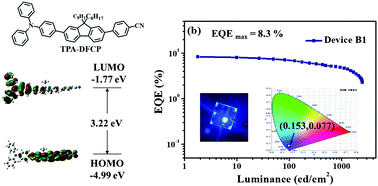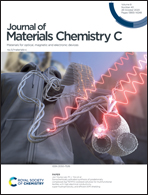Deep-blue fluorescent emitter based on a 9,9-dioctylfluorene bridge with a hybridized local and charge-transfer excited state for organic light-emitting devices with EQE exceeding 8%†
Abstract
It is indispensable to synthesize deep-blue light emitting materials with high luminous efficiency for realizing full-colour organic light emitting diode (OLED) displays. The hybridized local and charge-transfer (HLCT) state is a special excited state that hybridizes the local state and the charge transfer state to ensure a high fluorescence quantum yield (ηpl). Herein, a blue fluorescent material of TPA-DFCP was designed and synthesized, with a twisted D–π–A configuration, in which triphenylamine (TPA), benzonitrile (CP) and 9,9-dioctylfluorene serve as the D, A, and π-conjugation unit, respectively. It also exhibits good solubility and can be dissolved in several organic solvents with different polarities. The non-doped device, with TPA-DFCP as the emitter, shows excellent electroluminescent (EL) efficiency with a maximum EQE of 7.74%. Furthermore, the doped device of TPA-DFCP exhibits excellent deep-blue emission with the EL emission peak at 436 nm and the CIE coordinates at (0.153, 0.077), which are very close to the NTSC standard blue CIE (x, y) coordinates of (0.140, 0.080). Meanwhile, the doped device also exhibited excellent EL performance, with a maximum external quantum efficiency (EQE) and radiative exciton utilization (ηr) of 8.30% and 57.67%, respectively.



 Please wait while we load your content...
Please wait while we load your content...